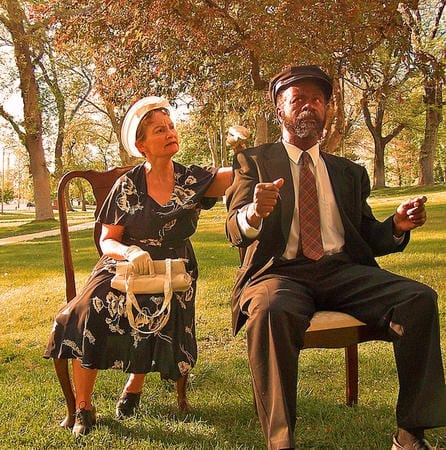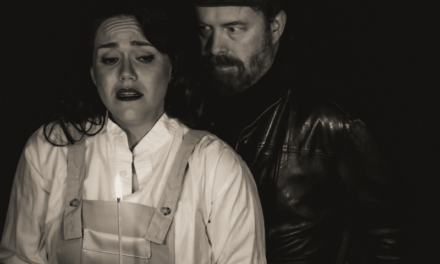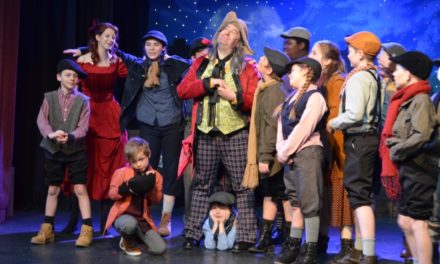SALT LAKE CITY — Daisy asks, “Did you have the air-conditioning checked? I told you to have the air-conditioning checked.” Hoke replies, “I had the air-conditioning checked. I don’t know what for. You never allow me to turn it on.” Then Daisy retorts, “Hush up!” This exchange summarizes the humorous and unlikely relationship between Daisy and Hoke that develops during the course of the play. Though this famous script has past the quarter century mark since its 1987 debut, it hasn’t aged a bit. The topics addressed and well-written dialogue feels fresh and relevant to a 2014 audience.
Set in Atlanta in the late 1940’s, “Driving Miss Daisy” follows the story of Daisy Werthan (Jayne Luke), an elderly Southern Jewish widow and her African American chauffeur Hoke Coleburn (Curley Green). In a series of warm-hearted, humorous scenes spanning 25 years, the two develop an unlikely bond despite their mutual differences, growing closer and more dependent upon one another and exploring the changing times of America during this span. Issues such as racism, prejudice, ant-Semitism and other social issues are explored. This Pulitzer Prize winning script by Alfred Uhry, was adapted into a 1989 film which went onto receive four academy awards. And a new stage revival starring Angela Lansbury and James Earl Jones will be broadcast in movie theaters throughout the US next month.
With such acclaim, it is appropriate that Walk-ons, should bring this classic to Utah. The cast was made up of well-seasoned actors and casting was appropriate to each respective part. Luke had the mannerisms and edge of Daisy down perfectly. Green as Hoke was successful in his subtle humor and reactions to Luke’s stubborn and difficult requests. The two of them established an entertaining and believable relationship. Justin Ivie as Daisy’s son Boolie (and who also served as the director) brought humor and charm to his scenes as he served as the mediator between Daisy and Hoke.
The largest obstacle to the production was the venue—the Ladies Literary Club was not conducive to this intimate piece. The acoustics in the high ceiling historic building created an echo and the lack of microphones made it challenging to hear many of the lines. I was sitting on the second row and was missing many lines, especially when actors were further upstage, their voices simply didn’t carry. I wish Ivie would have helped his actors to project and “play to the back of the house.” Of the three actors, Ivie himself projected well and acted in a style appropriate to the venue. However, Luke and Green were much too small in their performances, and much was lost behind the first couple of rows. In a more intimate setting or on film the subtle performances would have worked fine, but not in this venue.
Additionally, the energy of the show stayed largely on the same level and lacked much needed contrast in emotion and pacing changes. This caused some of the more poignant and dramatic moments of the play to be lost. An example of this was the pivotal scene where Daisy becomes confused and experiences some dementia; during this scene she can’t seem to find her school papers that she thinks Hoke has taken, and becomes distraught because she will be late for school, though she retired from teaching 30 or 40 years prior. This scene was a pivotal point in the plot, though the subdued emotions kept the scene from reaching the climax and the jarring impact was lost.
The story follows a 25-year span and requires the actors to age considerably during this time span. I had trouble believing this aging of the characters, and other than a slight graying of the hair and minor wardrobe changes, there were no noticeable physicality changes from the actors or make-up to assist in this much needed transformation. The actors appeared relatively the same age from start to finish, particularly Hoke, who is suppose to age from his 60’s to 80’s during the play.
Despite these problems, there were a lot of memorable scenes and moments created by the actors. The scene where Daisy calls her son over because of a “stolen” can of salmon was very entertaining. Likewise a scene between Hoke and Boolie where Hoke instructs Boolie not to drop ashes on his seat was terrifically funny; the facial expressions and reactions between Green and Ivie were perfect. Some of the more tender moments were touching, such as the scene where Hoke and Daisy discuss prejudices they have each experienced when the Jewish temple is bombed and Hoke recounts a story of a lynching of boyhood friend. Luke’s quiet and sincere emotion she showed during this scene was touching.
The set was simple, yet adequate for the story, in creating a unit set of Daisy’s living room. The transformation of furniture and set pieces from the living room into the various cars used throughout the show and other settings worked well. I appreciated the detail and physical humor implored by the actors, as they would pantomime opening car doors or reacting to being in a moving vehicle. I had no problem going along on this journey. However, the decision to have the office on the floor level in front of the stage in a spotlight did not work. Most of the dialogue was lost and the sight-lines were blocked. The choice of music was appropriate and aided the transitions between scenes and passing of time, as well as helped to establish the mood and time period.
Though the budget and venue limitations stifled the production from reaching high caliber, Uhry’s award winning script and some strong moments in the production make taking the ride with Miss Daisy a worthwhile trip.








